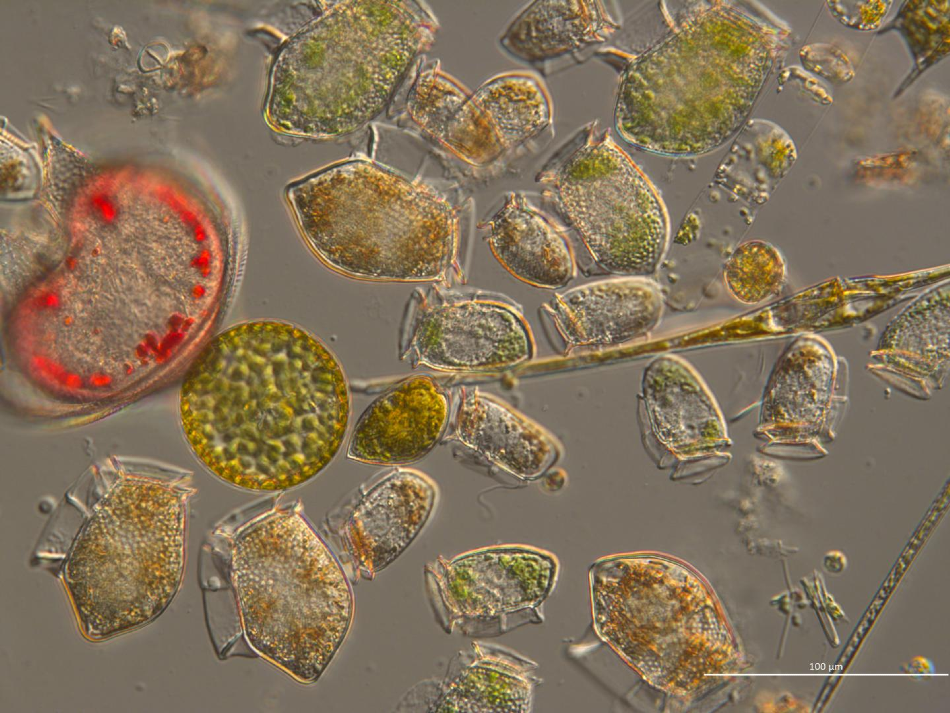Jun 8 2020
In the past six decades, the changing climate has resulted in a shortage of summer nutrients that has contributed to a 50% reduction in crucial North-East Atlantic plankton.
 A mixture of dinoflagellates and diatoms from the L4 coastal monitoring site off Plymouth, England. Image Credit: Claire Widdicombe.
A mixture of dinoflagellates and diatoms from the L4 coastal monitoring site off Plymouth, England. Image Credit: Claire Widdicombe.
Published in the Global Change Biology journal, the latest study demonstrates that larger and nutritious plankton—crucial to support marine mammals, seabirds, and fish—are being substituted by small, primary producers that have poorer food quality.
Variations caused by wetter and cloudier summers to longer periods of drought and sunshine have depleted the supply of nutrients and iron to surface waters. As a result, there has been a longer period of suboptimal feeding conditions for zooplankton, especially at a time of year when their metabolic demand is at its peak.
Huge phytoplanktons in certain regions are being almost entirely substituted by picoplankton, particularly the cyanobacterium Synechococcus that thrives when there are very low concentrations of nitrogen and iron in surface waters.
But cyanobacterium is small in size and does not contain any vital biomolecules, which means it is incapable of functioning in the same manner as larger and more nutritious phytoplankton—a key primary producer of omega-3—and cannot efficiently maintain shelf seafood webs.
Since Synechococcus are popular from the Arctic to the tropics and grow abundantly across the world, researchers have recommended that competition for limited summer nutrients will become a major force in shaping the shelf seafood webs.
Nearly 80% of the world’s wild-captured seafood is provided by shelf seas, which means variations in their productivity will have considerable impacts on mankind.
The study was performed under the guidance of researchers from the University of Plymouth (financially supported via the Shelf Sea Biogeochemistry Programme of Natural Environment Research Council), working with collaborators from the Marine Biological Association, Plymouth Marine Laboratory, and the University of Southampton.
The research brought together specialists from a variety of fields, such as satellite data, plankton taxonomy, and trace metal analysis.
Zooplankton such as copepods are considered beacons of climate change, and the ~50% decline in their abundance over the last six decades is worrying. Our study is the first to provide a mechanism for such a wide-spread decline, and this understanding is essential to project future responses to climate change.
Dr Katrin Schmidt, Study Lead Author and Plankton Ecologist, School of Geography, Earth and Environmental Sciences, University of Plymouth
Schmidt added, “We also need to explore the wider impacts and whether the changing nutrient supply could, for example, lead to reductions in omega-3 within the entire food chain.”
The research was based on a region spanning 2000 x 1500 km in the North-East Atlantic and employed a combination of data produced by satellites and the Continuous Plankton Recorder (CPR) survey of MBA. It enabled the researchers to determine both shorter- and longer-term trends, the spatial degree of any variations, and the months that are highly impacted.
It also makes use of the close field observations of the phytoplankton community and, by connecting the two scales, offered a conceptual model of why the traditional food web is growingly under threat in temperate coastal and shelf regions.
Combined together, CPR data and satellite data exhibit analogous variations over the shorter (1997-2018) and longer (1958-2017) terms. From May to August/September in those years, the proportions of dinoflagellates, diatoms, and total copepods have all decreased, while the number of picophytoplankton has increased.
The increasing dominance of small phytoplankton species might have a broad impact on the marine ecosystem. Other than altering the food chain as suggested in this study, it could also change the biological carbon pump modifying the capacity of the ocean to store carbon.
Dr Luca Polimene, Study Co-Author and Senior Marine Ecosystem Modeller, Plymouth Marine Laboratory
Polimene added, “We need to make sure that the shift between large to small phytoplankton species is well captured by marine ecosystem models if we want to reliably simulate future oceans.”
While the CPR Survey samples the larger plankton community, declines in some key groups over past decades can be linked to changes in the smallest plankton that are driven by climate change.
David Johns, Head of Continuous Plankton Recorder Survey, University of Plymouth
Johns continued, “We have previously witnessed direct climate impacts on the plankton community, from seasonality (temporal) to large scale movements (spatial), via changes in temperature.”
“This study demonstrates a knock-on effect through the food web, and it is only by continuing our monitoring that we will identify multiple stressors acting on our marine environment, and hopefully sustain and protect our productive oceans,” Johns concluded.